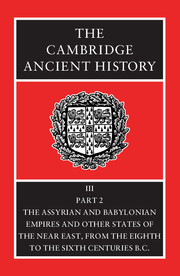Book contents
- Frontmatter
- Contents
- List of maps
- List of text-figures
- Preface
- PART I ASSYRIA AND BABYLONIA
- PART II THE EASTERN MEDITERRANEAN AND THE BLACK SEA
- 29 Israel and Judah from the coming of Assyrian domination until the fall of Samaria, and the struggle for independence in Judah (c. 750–700 B.C.)
- 30 Judah until the fall of Jerusalem (c. 700–586 B.C.)
- 31 The Babylonian Exile and the restoration of the Jews in Palestine (586–c. 500 B.C.)
- 32 Phoenicia and Phoenician colonization
- 33 Scythia and Thrace
- 34 Anatolia
- 35 Egypt: the Twenty-fifth and Twenty-sixth Dynasties
- Chronological Table
- Note on The Calendar
- BIBLIOGRAPHY
- Index
- Map 11: Phoenician and Punic sites in Spain
- Map 13: Scythia
- Map 14: Thrace
- References
35 - Egypt: the Twenty-fifth and Twenty-sixth Dynasties
from PART II - THE EASTERN MEDITERRANEAN AND THE BLACK SEA
Published online by Cambridge University Press: 28 March 2008
- Frontmatter
- Contents
- List of maps
- List of text-figures
- Preface
- PART I ASSYRIA AND BABYLONIA
- PART II THE EASTERN MEDITERRANEAN AND THE BLACK SEA
- 29 Israel and Judah from the coming of Assyrian domination until the fall of Samaria, and the struggle for independence in Judah (c. 750–700 B.C.)
- 30 Judah until the fall of Jerusalem (c. 700–586 B.C.)
- 31 The Babylonian Exile and the restoration of the Jews in Palestine (586–c. 500 B.C.)
- 32 Phoenicia and Phoenician colonization
- 33 Scythia and Thrace
- 34 Anatolia
- 35 Egypt: the Twenty-fifth and Twenty-sixth Dynasties
- Chronological Table
- Note on The Calendar
- BIBLIOGRAPHY
- Index
- Map 11: Phoenician and Punic sites in Spain
- Map 13: Scythia
- Map 14: Thrace
- References
Summary
THE ORIGINS OF THE TWENTY-FIFTH DYNASTY
The historical tradition preserved in the pages of Manetho's history allows three kings to the Twenty-fifth Dynasty, Sabacon, Sebichos, and Tarcos, to be identified with Shabako, Shebitku, and Taharqa. These three are the middle monarchs of the five now generally included together to make the historical Twenty-fifth Dynasty of the monuments. Historians have expressed surprise that Manetho made no mention of Py (Piankhy), who established the fortunes of his line in Egypt, but his absence from the chronicler's list may be due more to a desire for chronological tidiness than to ignorance or malicious omission. For the greater part of his reign Py was absent from Egypt, and, as an earlier chapter of this history made clear, much of Egypt during this period was controlled by princes and chieftains, some of whom form, in Manetho's tradition, the lines of the Twenty-third and Twenty-fourth Dynasties. The overlap of dynastic lines presents problems to the annalistically-minded historian. To start the Twenty-fifth Dynasty with Shabako, who earned the royal title ‘King of Upper and Lower Egypt’ by extending Nubian rule over the whole land in about 713 B.C., was altogether neater.
Unfortunately, neatness is not customarily to be observed in the sequences of historical events. The narrative of a country's history is like a river which, from time to time along its course, is joined by tributaries. Each tributary represents a new stream which, to be fully understood, needs retracing back along its separate course.
- Type
- Chapter
- Information
- The Cambridge Ancient History , pp. 677 - 747Publisher: Cambridge University PressPrint publication year: 1992

